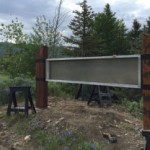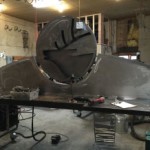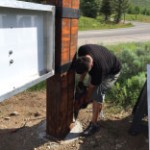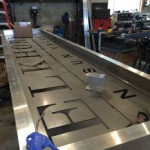Windy City Arts is a local service-oriented family business that sets the tone for locally crafted signage. With a skilled staff, precision machinery, and installation services in-house, the Windy City team can install a sign in the ground in as few as 21 days after the go-ahead, and customers feel the sign is exactly what they want. How does Windy City do this?
“We have worked out a process that allows us to understand the need and vision, and we work efficiently to express it in a minimal timeframe. Because we do everything in-house, we have the ability to directly control of the process and schedule,” answers Larsen, owner of Windy City Arts, who is always conscious of the team effort required. To explain this process, he uses the example of new signs just completed for the north and south gateways of Elkhorn, which Larsen describes as rustic with modern elegance.
“We meet on the site to evaluate the existing conditions and ask questions,” Larsen explains. “At this point, we observe colors and note what will work with the property or buildings. We listen to answers: What are you looking for? What materials appeal to you? Are you drawn to rustic, modern, or a combination? Often we start with more a sense of what they don’t want, and then narrow down to what they like.”
Other questions follow, like the decision to illuminate, whether to include a logo, and colors: which colors support the logo and are compatible with the surroundings. If a new logo is needed, one of the three graphic artists at Windy City can execute one. “Once we sense the feel and read what the client wants, we essentially work backwards with structurally sound options and specific materials,” says Larsen, introducing

Step 2.STEP 2: Design, Proofing, and Estimates
At this point, the technically well-versed staff design up to four very detailed options with Adobe Illustrator and an array of state-of-the art design programs for the client to review, called proofing sheets. The designs specify the materials, thicknesses, colors, textures, and font for a true sense of the finished product. Structural design addresses support for mounting and the hardware attachments. “For monument signs, the support system is important both to the image and the sign’s life. We can use steel posts, concrete and stone, or milled timber wood posts.”
STEP 3: Final Design Decision
With up to four possible designs, the client can decide to move forward with one of the options or a hybrid with tweaks and changes that blend elements.
STEP 4: Production/Fabrication
At this step, the fully equipped, highly technical workshop at Windy River Arts shines. A plasma cutter creates the crisp fine edges on metal, a CNC router shapes metal and wood, and a solvent printer creates printed elements. With cutting, finishes, patina, and painting in-house, most of production occurs right in the Wood River Valley shop, avoiding costly delays due to out-sourcing and shipping.

STEP 5: Installation
“When our clients are satisfied with the final product, then we as a company are completely satisfied,” explains Larsen, indicating a folder he keeps with letters and emails from clients expressing appreciation for the completed signs. “That’s the pleasure of this work, along with knowing that our work enhances the area and makes it an even more appealing destination. We are very aware that we are part of this community, and we know what we do can affect it positively or negatively. We have a responsibility to do our part to keep beautiful.”

